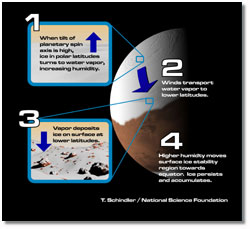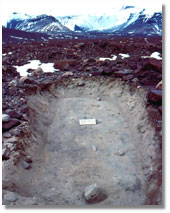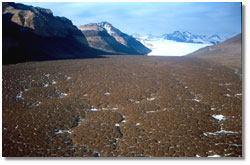 |
|
|
 |
||
|
||||||||||||||||
|
Images/B-Roll: For Betacam SP B-roll of the Antarctic Dry Valleys, please contact Dena Headlee, dheadlee@nsf.gov, (703) 292-7739
Landscapes on Buried Glaciers in Antarctica's Dry Valleys
Help Decipher Recent Ice Ages on Mars
|
||||||||||||||||
|
ARLINGTON, Va.—Studies of the unique landscape in the Dry Valleys of Antarctica provide new insights into the origin of similar features on Mars and provide one line of evidence that suggests the Red Planet has recently experienced an ice age, according to a paper in this week’s issue of the journal Nature. The distribution of hexagonal mounds and other features on the Martian surface at mid-latitudes similar to those in the Dry Valleys also supports previous scientific assertions that a significant amount of ice lies trapped beneath the Red Planet’s surface. David Marchant, a Boston University researcher who has studied the Dry Valleys for 17 years, co-authored the paper with James W. Head (lead author), John Mustard and Ralph Milliken, at Brown University, and Mikhail Kreslavsky of Kharkov National University in Ukraine. The National Science Foundation (NSF) supported Marchant’s work in the Dry Valleys, which helped underlie the assertions in the Nature paper. NSF is an independent federal agency that supports fundamental research and education across all fields of science and engineering. NSF manages the U.S. Antarctic Program, which supports and coordinates virtually all U.S. scientific research on the southernmost continent. Head, Mustard and Milliken were supported by NASA. The floor of Antarctica’s Beacon Valley, in particular, is covered with hexagonal mounds that, from the air, resemble the patterns of cracked mud on a dry lakebed. The Dry Valleys mounds, however, often measure meters in diameter. Although these polygon-shaped features occur throughout the Arctic and Antarctic, an unusual variety found in the western Dry Valleys region has received particular attention because it forms only in perennially frozen soils with significant ice content. These polygons form as sub-freezing temperatures fluctuate, causing the underlying ice to contract in a hexagonal pattern. As the ice contracts, fine sediments sift down into the cracks, leaving a coarse-grained deposit covering the ice. The research reported in Nature shows that similar mounds and other formations that appear in the mid-to-high latitudes on Mars could indicate ice buried near the planet’s surface as well. Using new information on the global distribution of surface landforms on Mars, together with data gathered from NASA’s Mars Global Surveyor and Mars Odyssey missions, Head and other researchers were able to piece together a history of recent ice ages on Mars. “The last ice age on Mars began about 2.1 million years ago and ended as recently as 400,000 years ago,” according to Head. Like ice ages on Earth, Martian ice ages are driven by variations in the planet’s orbit, particularly the tilt of the planet’s axis. But Martian ice ages, unlike ice ages on Earth, appear to begin as the polar regions warm, rather than cool. Warming of the Martian Poles causes the planet’s ice caps to partially vaporize and release water vapor into the Martian atmosphere. Winds transport the water vapor, along with ubiquitous Martian dust, toward the equator and deposit it in a meters-thick layer as far as 30 degrees north and south latitude. There, it drapes over existing terrain, smoothing the Martian surface. Head and his co-authors report that emplacement of this meters-thick layer of snow and dust at 30 degree latitudes represents an “ice age” on Mars. The small number of impact craters seen in these features, along with the known patterns of changes in Mars' orbit and tilt, are used to estimate the age of these Martian ice ages. The Nature findings complement a paper recently published in the journal Geology, in which Head and Marchant argue that features on the surface of the Red Planet are remarkably like glacial features found only in the Dry Valleys. The findings not only have implications for the search for microbial life on Mars, but also may help scientists better understand the unique Polar desert environment of the Dry Valleys, and in particular the ancient climate record that may be stored in the landscape. "These extreme changes on Mars provide perspective for interpreting what we see on Earth. Landforms on Mars that appear to be related to climate changes help us calibrate and understand similar landforms on Earth. Furthermore, the range of microenvironments in the Antarctic Dry Valleys helps us read the Mars record," said Marchant. If the analogy between the geologic processes on Mars and those in the Dry Valleys holds true, then scientists may conclude that Mars may be more hospitable to microbial life than previously suspected. Biologists continue to make discoveries that push back the boundaries at which conditions are too extreme to support life. NSF-funded researchers, for example, have offered evidence that microbes can survive in extremes of cold and darkness between ice crystals at the South Pole. Although the Dry Valleys were thought to be a virtual dead zone when first explored a century ago, new evidence suggests that the lakes and other landscape features support microscopic life. Principal Investigator: David Marchant, (617) 353-3236, marchant@bu.edu The National Science Foundation (NSF) is an independent federal agency that supports fundamental research and education across all fields of science and engineering, with an annual budget of nearly $5.3 billion. NSF funds reach all 50 states through grants to nearly 2,000 universities and institutions. Each year, NSF receives about 30,000 competitive requests for funding, and makes about 10,000 new funding awards. The NSF also awards over $200 million in professional and service contracts yearly. Receive official NSF news electronically through the e-mail delivery system, NSFnews. To subscribe, send an e-mail message to join-nsfnews@lists.nsf.gov. In the body of the message, type "subscribe nsfnews" and then type your name. (Ex.: "subscribe nsfnews John Smith") Useful NSF Web Sites: |
Larger versions (Total Size: 2,543KB) of all images from this document |
|
|
|




